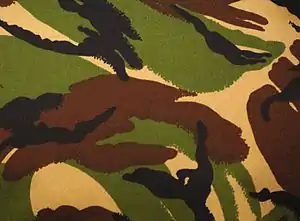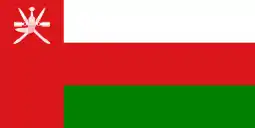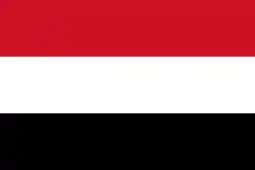Disruptive Pattern Material
Disruptive Pattern Material (DPM) is the commonly used name of a camouflage pattern used by the British Armed Forces as well as many other armed forces worldwide, particularly in former British colonies.
| Disruptive Pattern Material | |
|---|---|
 British DPM Soldier 95 camo pattern | |
| Type | Military camouflage pattern |
| Place of origin | United Kingdom |
| Service history | |
| In service | 1960–2016 (for main UK forces) |
| Used by | See Users |
| Production history | |
| Designed | 1960 |
| Produced | 1969 - Present |
| Variants | See Variants |
The main variants of DPM are a four-colour woodland pattern, and desert patterns in two, three or four colours. The Woodland Pattern DPM was used with the mediumweight No.8 Temperate Combat Dress (c.1966/1968) and lightweight No.9 Tropical Combat Dress (c.1976). The later Desert Pattern DPM (c.late 1980s) was designated the No.5 Desert Combat Dress.[1]
DPM has also been produced in black/white/grey Urban DPM, in various blue tones and even in purples (this last for the Swazi Royal Guard).
DPM has been phased out in British military service, superseded by Multi-Terrain Pattern.[2]
History
The British Army first used a form of DPM for the famous Denison smock issued to the Parachute Regiment and British Commandos from the early 1940s. The first examples of this design were said to be hand-painted.[3] The Denison smock design went through minor changes, and continued in use with the Royal Marines and the Parachute Regiment until the 1970s.
Development
1960 Pattern
From 1960, the British Army was issued with the so-called 1960 Pattern field-uniform range to replace earlier plain green uniforms. The 1960 Pattern field-uniform consisted of a Combat Smock, Combat Trousers, a Combat Hood attached to the smock by two epaulette buttons and a third button concealed under the collar, and, for exceptionally cold conditions, a Parka.[4]
First limited use
A new British DPM was developed in the early 1960s, using the four basic western European temperate colours of black, dark brown, mid-green and a dark sand to make a very effective camouflage that has survived in its basic design, with no more than slight changes to the colours and pattern, until current times.
This design was probably used first on a very small scale for a hooded Smock, Windproof, 1963 Pattern, issued only to special forces.
In 1966 the Army introduced, though not universally, a camouflage field uniform. Known informally as the 1966 Pattern, it was in fact identical in design to the 1960 Pattern kit, though now made in DPM fabric. It is labelled, like the earlier plain olive green version, Smock, Combat, 1960 Pattern and Trousers, Combat, 1960 Pattern.
The 1966 DPM range did not completely replace the plain olive green 1960 Pattern Smock and Trousers, which continued to be worn widely until the 1968 DPM kit was issued. Both the Royal Marines and the Parachute Regiment continued to wear the Trousers, Combat, 1960 Pattern with the Denison smock, and examples of these trousers were made even after 1968. These units eventually stopped issuing the Denison smock (in mid to late 1970s) and adopted smocks in the general-issue DPM while still for a time wearing the plain olive 1960 Pattern Trousers.
The 1968 Pattern range—first general use
Before the 1966 Pattern equipment had reached all units a slightly revised design of Smock, Combat and Trousers, Combat were introduced as the 1968 Pattern range. The 1966 Pattern DPM fabric design was changed very little for the 1968 issue, and it seems that the 1968 Pattern garments were made for some time in the two very similar DPM fabrics. A Hood, Combat, DPM, made of DPM cotton fabric and with a plain olive green lining, was also included in the range, fastened as required to the back of the Smock with the two epaulette buttons and a third under the collar.
In doing this the British Army was the first to adopt a camouflage uniform universally.
For the Royal Marines, which had a responsibility for NATO's northern flank, a Smock, Windproof, Arctic and Trousers, Windproof, Arctic were introduced circa 1972. These were made in a lightweight, but wind-proof, DPM fabric and could be worn over quilted jacket and trousers in extreme cold conditions. The design of both smock and trousers differ radically from both the standard and para designs. The smock is long and loose-fitting, and incorporates a voluminous wired-rim hood, while the trousers have zips in the lower leg to allow them to be put on over boots.
In the mid 1970s a new Smock Parachutist DPM (Para smock) was introduced for the Parachute Regiment and other airborne units. Though made in the 1968 Pattern cotton fabric, its design was closer to that of its predecessor, the Denison smock.
At the same time a Smock, Sniper, was introduced, based heavily on the Smock Parachutist DPM and sharing many of its details. It was distinguished by its padded elbows and shoulders, relocated lower pockets, multiple loops for securing natural camouflage material and hooks for the rifle sling.
During the late 1970s, batches of the 1968 Pattern camouflage were used by the USAF Police Tactical Neutralisation Teams at RAF Upper Heyford as a temporary stand-in for the ERDL/M81 Woodland fatigues.[5]
Later developments

The pattern was changed slightly with subsequent issues. On early 1960 Pattern (manufactured from 1966) and 1968 Pattern DPM uniforms the sand coloured base would appear to lighten in tone at night, becoming dangerously conspicuous. This was addressed in the late 1970s, when the sand and brown colours were slightly darkened. The 1985 Pattern has fewer, less precise dots and the brown is much darker; 1990 and later has a band of new shapes and is smaller; 1994 has an orangey colour instead of a tan. Tropical poly-cotton DPM uniforms varied even more; early versions were very brightly coloured notably with a russet brown and emerald green which faded to rather unexpected pastel tones of blueish green and pink-brown with washing. Late 1970s and early 1980s Tropicals have a more yellowish sand base and are greatly sought-after by those wishing to appear stylish, while the final production style in the early 1990s used colours closer to temperate uniforms.
DPM items in the Combat Soldier 95 clothing system have similar colours to the 1966 uniform. However, instead of all four colours being printed onto a whitish base, the material is in fact woven in the sand shade and overprinted only with three colours. This leads to a loss in contrast between the colours after washing and wear, and the clothing tends to appear darker when wet than previous types did.
Although slight changes have been made to DPM and the colours, the pattern is easy to recognise. There are also jungle versions of DPM where the colours are brighter, and on one variation the tan is darker than the green.
From 1990 a system of Personal Load Carrying Equipment was introduced, initially produced in olive green. The olive type was quickly replaced in production by a disruptively patterned version, and now almost all British issue webbing and rucksacks are disruptively patterned in the Multi-Terrain Pattern (MTP).[6]
Current issued DPM equipment is IRR (Infrared Reflective) coated. This coating has a specific reflective wavelength in order to blend in with natural colours in the infra-red light spectrum.[7] This reduces the visibility of soldiers to night vision devices, which detect infra-red light, as trees and other green plants reflect deep red and infra-red light (the Wood Effect).
Desert variants

A desert variant was first issued on a limited basis in the late 1980s consisting of subdued sand and khaki hues but was replaced by a two-colour light brown on sand[8] version by 1990 because four-colour (light and dark browns, khaki, and sand) versions had been adopted by some Middle Eastern countries, notably Kuwait and the Iraqi Republican Guard.[8] It is also currently worn by members of the Indonesian National Armed Forces assigned to the Garuda Contingent serving in UN Peacekeeping operations in UNIFIL.[9]
A three colour (reddish brown, khaki, and sand) version also exists and was worn by Syria,[10] Lebanese Forces,[11] and the Saudi Arabian National Guard.[8]
 Examples of the four-colour variant of Desert DPM.
Examples of the four-colour variant of Desert DPM. Dr Liam Fox MP visiting British troops in Kandahar, Afghanistan in November 2007.
Dr Liam Fox MP visiting British troops in Kandahar, Afghanistan in November 2007.
Variants
New Zealand DPM
GVT M93
A development of DPM used by the Armed forces of the Netherlands
Users
Current
 Hong Kong: Used by the Hong Kong Police Force.
Hong Kong: Used by the Hong Kong Police Force. Indonesia: Used by the Indonesian National Armed Forces (TNI) since 1984.[12]
Indonesia: Used by the Indonesian National Armed Forces (TNI) since 1984.[12] India: Uses Indian-made DPMs, currently only used by Airforce personnel.[13]
India: Uses Indian-made DPMs, currently only used by Airforce personnel.[13] Jamaica: DPM camo used by the Jamaican Defense Force since 1992 will be replaced by Hypersteath's Digital Combat Uniform.[14]
Jamaica: DPM camo used by the Jamaican Defense Force since 1992 will be replaced by Hypersteath's Digital Combat Uniform.[14] Oman[15]
Oman[15] Papua New Guinea: The Papua New Guinean military uses Kumul DPM camos made in Australia.
Papua New Guinea: The Papua New Guinean military uses Kumul DPM camos made in Australia. Philippines: The Filipino-made DPM used by the Armed Forces of the Philippines, slowly being replaced by PHILARPAT as of 2017.[16]
Philippines: The Filipino-made DPM used by the Armed Forces of the Philippines, slowly being replaced by PHILARPAT as of 2017.[16] Russia: DPM clones known as Smog.[17]
Russia: DPM clones known as Smog.[17] Serbia: Used by the SAJ only in operations outside cities/towns.[18]
Serbia: Used by the SAJ only in operations outside cities/towns.[18] Sri Lanka: Special Task Force[19]
Sri Lanka: Special Task Force[19] Ukraine: Used by the Ukrainian military.[20]
Ukraine: Used by the Ukrainian military.[20] United Kingdom: Blue DPM used by British soldiers in OPFOR roles since 2015, and certain Cadet units still wear the pattern.[21]
United Kingdom: Blue DPM used by British soldiers in OPFOR roles since 2015, and certain Cadet units still wear the pattern.[21]
Former
.svg.png.webp) Australia: Formerly used by Royal Australian Air Force from 1970s-1980s.
Australia: Formerly used by Royal Australian Air Force from 1970s-1980s..svg.png.webp) Bophuthatswana: Used on military uniforms.
Bophuthatswana: Used on military uniforms. Brunei: Already replaced by Digital Disruptive Pattern-based BDUs made by Force-21 equipment in 2011.[22][23]
Brunei: Already replaced by Digital Disruptive Pattern-based BDUs made by Force-21 equipment in 2011.[22][23].svg.png.webp) Canada: Known to be used by airborne-trained soldiers.[24] Small number of Desert DPMs bought for Canadian soldiers involved in UNIKOM.[25]
Canada: Known to be used by airborne-trained soldiers.[24] Small number of Desert DPMs bought for Canadian soldiers involved in UNIKOM.[25] Croatia
Croatia Iran[15]
Iran[15] Iraq: Known to be formerly used by the Iraqi military.
Iraq: Known to be formerly used by the Iraqi military. Kuwait[15]
Kuwait[15] Netherlands: From 1991-2011, known as M91 DPM.[26] Some still in operational use.[26]
Netherlands: From 1991-2011, known as M91 DPM.[26] Some still in operational use.[26] New Zealand: From 1980-2013. See New Zealand disruptive pattern material for more details.
New Zealand: From 1980-2013. See New Zealand disruptive pattern material for more details.
- Formerly used a New Zealand version of the Desert DPM.
 Pakistan: DPM-based camos used by the SSG.[27]
Pakistan: DPM-based camos used by the SSG.[27] Philippines: Red DPM formerly used by Philippine Coast Guard.[28]
Philippines: Red DPM formerly used by Philippine Coast Guard.[28] Portugal: Adopted to replace their Lizard camo uniforms.[29][15]
Portugal: Adopted to replace their Lizard camo uniforms.[29][15] Romania: Used DPM until 2017.[29]
Romania: Used DPM until 2017.[29].svg.png.webp) Union of South Africa: Hunter Group and 32 Battalion operators use DPM-based clothing/gear in the South African Border War.[30][31]
Union of South Africa: Hunter Group and 32 Battalion operators use DPM-based clothing/gear in the South African Border War.[30][31] Slovenia
Slovenia Sri Lanka: Used by the Sri Lanka Army Commando Regiment.[13]
Sri Lanka: Used by the Sri Lanka Army Commando Regiment.[13] Thailand: Used by Thai special forces.[32]
Thailand: Used by Thai special forces.[32] United Kingdom: Desert and woodland patterns used by British Armed Forces. Woodland pattern also used by Combined Cadet Force and Community Cadet Forces until the adoption of Multi-Terrain Pattern.[33][34]
United Kingdom: Desert and woodland patterns used by British Armed Forces. Woodland pattern also used by Combined Cadet Force and Community Cadet Forces until the adoption of Multi-Terrain Pattern.[33][34] Yemen[15]
Yemen[15]
Others
- Known to be used by anti-Assad forces in Syria.[35]
- Provisional Irish Republican Army[36]
Replacement
Multi-Terrain Pattern (MTP) is a six-colour camouflage pattern intended to replace both the four colour woodland DPM uniform and the desert pattern uniform used by the British Armed forces. MTP was procured and announced in late 2009, predicated around use in the Afghanistan theatre of operations but applicable to other theatres. A range of patterns were tried and evaluated in Britain, Cyprus, Kenya and Afghanistan against DPM, desert patterns and existing commercially available patterns. In April 2010 MTP combat uniforms began being issued to forces deployed in Afghanistan.[2][37]
It was intended for DPM to be phased out completely for British Regular and Reserve forces by 2016,[38] but the use of jungle pattern DPM could still be retained by special forces for jungle operations.
References
- Emery, Daniel (20 December 2009). "British Army to get new camouflage uniform". BBC. Retrieved 29 January 2017.
- Emery, Daniel (20 December 2009). "British Army to get new camouflage uniform". BBC News Online. Retrieved 22 January 2014.
- Drucquer, Amy (26 September 2013). "The Camo Collection". Lyle & Scott. Archived from the original on 22 January 2014. Retrieved 22 January 2014.
- "Trousers, Camouflage DPM Combat Dress 1968 pattern". Imperial War Museum. Retrieved 31 October 2015.
- Park, Duane (11 September 2011). "Air Police/Security Police". RAF Upper Heyford Memorial Website. Retrieved 22 January 2014.
- "Personal Clothing". Ministry of Defence. Retrieved 28 July 2016.
- "British DPM Webtex Under Armour Combat Shirt". Airsoft. 24 January 2009. Retrieved 28 July 2016.
- Armies of the Gulf War, Elite 45, Osprey Publishing 1993, Gordon L Rottman, ISBN 185532 277 3
- https://en.antaranews.com/news/93564/indonesia-aiming-to-be-among-key-contributors-of-peacekeeping-force%5B%5D
- Arab Armies of the Middle East Wars 1948-73, Osprey Military 128, John Laffin, 2000, ISBN 085045 451 4
- Armies in Lebanon 1982-84, Osprey Publishing, Men-at-Arms 165, Samuel Katz and Lee E Russell, 1985, ISBN 978-0-85045-602-8
- Conboy 1991, p. 56.
- Conboy 1992, p. 59.
- http://www.hyperstealth.com/Jamaica/
- Epochs. "Epochs Field Guide to Camouflage". epochs.co.
- https://web.archive.org/web/20180810072646/http://www.army.mil.ph/ASCOM/pdf_files/logistics_magazine.pdf
- Galeotti 2013, p. 14.
- "Specijalne-jedinice.com - Special Anti-terrorist Unit-SAU". specijalne-jedinice.com.
- Conboy 1992, p. 57.
- Galeotti 2019, p. 63.
- https://www.joint-forces.com/features/kit-camo/30955-uk-opfor-blue-disruptive-pattern-material
- https://force21.com.sg/newsandevents/royal-brunei-armed-forces-rbaf-awarded-force-21-with-three-contracts/
- http://www.sultanate.com/news_server/2011/1_jun_1.html
- https://www.joint-forces.com/features/kit-camo/23756-cadpat-tw-camo-royal-22e-regiment
- http://mpmuseum.org/securdesert.html
- https://www.joint-forces.com/features/kit-camo/30396-dutch-army-m91-disruptive-pattern-material
- Conboy 1992, p. 49.
- Martin. "Philippine Coast Guard K9 Unit red DPM trousers". www.camouniforms.net. Archived from the original on 2018-08-29. Retrieved 2020-03-27.
- https://web.archive.org/web/20200327072705/https://apps.dtic.mil/dtic/tr/fulltext/u2/1059969.pdf
- Pitta 1983, p. 54.
- Pitta 1983, p. 55.
- Conboy 1991, p. 58.
- "The Complex Guide To Camo1958, Tigerstripe, Vietnam". Complex.
- Copping, Jasper (20 December 2009). "British Army to get new uniforms – turned down by the US and made in China" – via www.telegraph.co.uk.
- "A snapshot of camouflage patterns in Syria – Armament Research Services". armamentresearch.com.
- https://ansionnachfionn.com/2014/08/19/analysis-of-onae-video/
- "New camouflage arrives in Afghanistan". Ministry of Defence. 21 May 2010. Retrieved 22 January 2014.
- Copping, Jason (20 December 2009). "British Army to get new uniforms – turned down by the US and made in China". The Daily Telegraph. Retrieved 22 January 2014.
Further reading
- Blechman, Hardy; Newman, Alex (2004). DPM: Disruptive Pattern Material. DPM Ltd. ISBN 0-9543404-0-X.
- Behrens, Roy R. (2002). FALSE COLORS: Art, Design and Modern Camouflage. Bobolink Books. ISBN 0-9713244-0-9.
- Behrens, Roy R. (2009). CAMOUPEDIA: A Compendium of Research on Art, Architecture and Camouflage. Bobolink Books. ISBN 978-0-9713244-6-6
- Conboy, Kenneth (1991). South-East Asian Special Forces. Osprey Publishing. ISBN 978-1855321069.
- Conboy, Kenneth (1992). Elite Forces of India & Pakistan. Osprey Publishing. ISBN 978-1855322097.
- Galeotti, Mark (2013). Russian Security and Paramilitary Forces since 1991. Osprey Publishing. ISBN 978-1780961057.
- Galeotti, Mark (2019). Armies Of Russia's War In Ukraine. Osprey Publishing. ISBN 978-1472833440.
- Pitta, Robert (27 May 1993). South African Special Forces. Osprey Publishing. ISBN 978-1855322943.
External links
| Wikimedia Commons has media related to Disruptive Pattern Material. |
.jpg.webp)